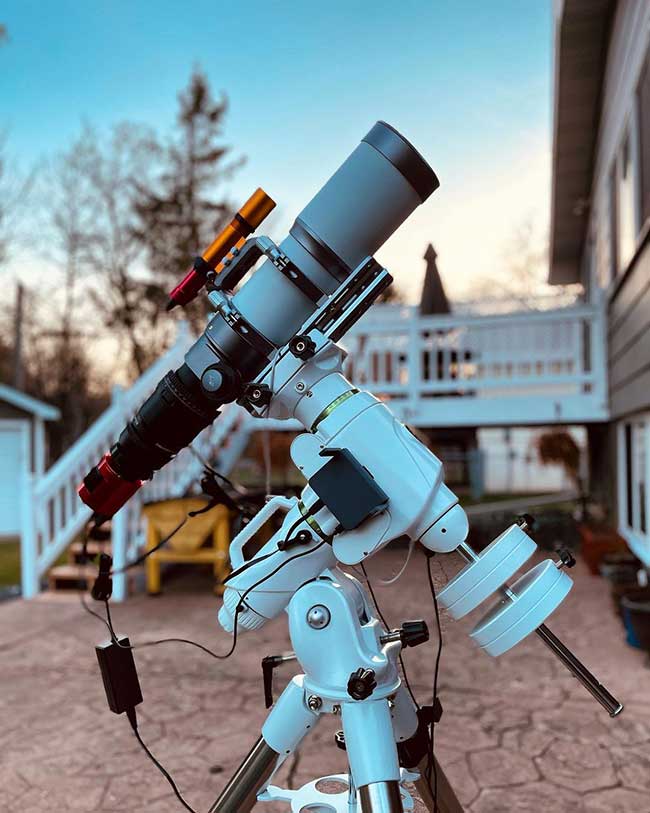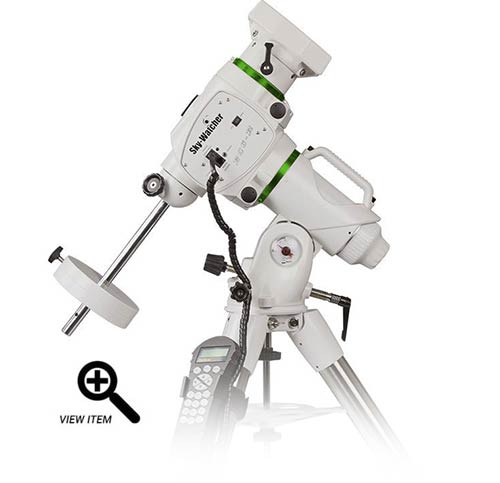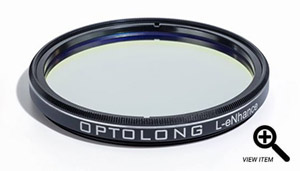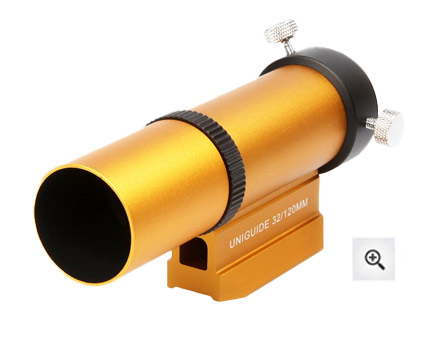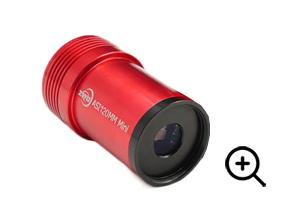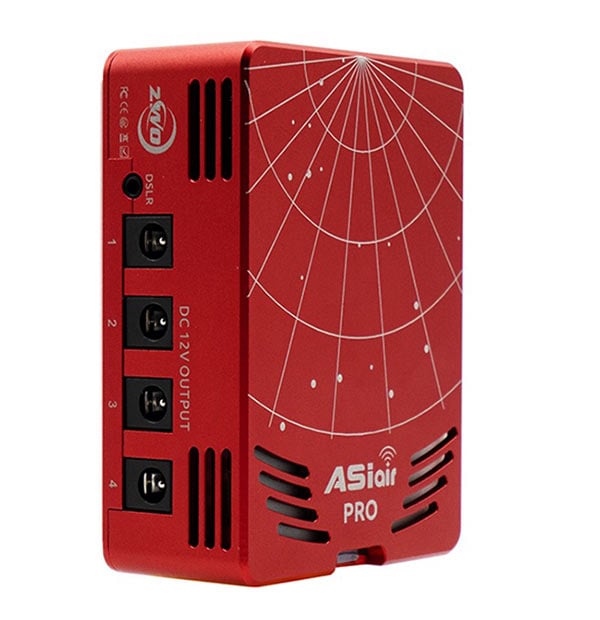Backyard of the Week | May 31, 2021
The AstroBackyard Backyard of the Week highlights astrophotography setups from around the world. A “backyard” can be a balcony, driveway, garden, or wherever else you set up astrophotography equipment at home.
For a successful deep space image, all of your photography gear must work together in harmony.
Putting together an astrophotography setup like this can be daunting at first, so we’ll break down each piece of a successful imaging system so you can get a better understanding of what’s required.
This week’s backyard astrophotography equipment profile comes to us from Jack Groves from Minnesota, USA.
Jack’s astrophotography equipment setup includes a reliable Sky-Watcher EQ6-R Pro equatorial telescope mount, with a beautiful wide-field imaging refractor riding on top. He uses a dedicated astronomy camera to capture detailed images of nebulae and galaxies from his backyard.
The William Optics FLT 91 refractor telescope pulls in deep space objects for a closer look with its 91mm diameter objective lens at F/5.9. I see a 2″ filter-slider drawer threaded between the camera and telescope adapter as well.
This is a practical configuration for those that wish to swap filters in front of the camera sensor without having to remove the camera.
I love the small autoguiding system mounted on top of the William Optics FLT 91 APO. The William Optics 32mm Guide Scope adds very little weight to the system, yet improves the tracking accuracy of the telescope mount by a large degree.
You’ll notice that Jack uses the ZWO ASIAir wireless camera controller to automate his imaging sequence, as well as communicate with the telescope mount for autoguiding.
Location: Minnesota, United States
Jack Groves
Jack has an impressive collection of deep space astrophotography images on his Instagram. I noticed a new photo of the Dumbbell Nebula captured just last weekend!
Not only does Jack share the images he captured, but a detailed description of the process and gear involved. This is extremely helpful for beginners looking to replicate a system that aims to produce similar results.
Jack Groves (@astrojackmn) on Instagram.
My favorite recent photo by Jack is the Iris Nebula. This image includes an impressive 13 hours of total integrated exposure time.
Jack’s post includes versions of this image with 8.7 hours and 3.5 hours of integration for comparison. This is a fantastic display of the power of integration and the signal-to-noise ratio at work.
The Iris Nebula by Jack Groves.
Jack’s Equipment
| Camera | ZWO ASI533MC Pro |
| Telescope | William Optics FLT91 Triplet APO |
| Mount | Sky-Watcher EQ6-R Pro |
| Filter(s) | Optolong L-Pro +L-Enhance |
| Guide Scope | William Optics 32mm Guide Scope |
| Guide Camera | ZWO ASI120MM Mini |
| Camera Control Software | ZWO ASIAir Pro |
What does Jack love most about his gear?
“Ease of use, versatile focal length, ability to control all aspects of my imaging from inside my house. Fast and accurate polar alignment, steady tracking. The list could go on!!”
I second Jack’s first point. An apochromatic refractor telescope at this focal length is an extremely versatile tool for a wide variety of deep space projects.
The William Optics FLT 91 has a focal length of 540mm, which brings in smaller DSO’s for a closer look, yet is wide enough to capture some of the most popular large nebulae in the sky.
The cooled CMOS camera Jack uses collects high-quality image data with much less noise than a DSLR/Mirrorless would. The ZWO ASI cameras are well supported and widely used in the amateur astrophotography community.
The Camera
The ZWO ASI533MC Pro has a lot going for it. This one-shot-color camera is capable of producing stunning images of space with an impressive dynamic range.
At the time of writing, the ASI533MC Pro is under $1K USD, making it one of the most affordable (cooled) dedicated astronomy cameras with a sensor large enough for nearly every type of deep space object you can imagine.
It shares the pixel size (3.76 microns) of some of my favorite astronomy cameras on the market like the QHY268C, and ZWO ASI2600MM Pro.
The ZWO ASI533MC Pro
The Telescope
Jack uses a William Optics Fluorostar (FLT) 91. This is a premium quality triplet APO (apochromat) capable of producing crisp, well color-corrected images. I personally own and enjoy the William Optics FLT 132 apochromatic refractor, and can attest to the exceptional image quality of the Fluorostar series.
I find this model is particularly attractive for backyard astrophotographers, as it may just be the perfect balance between aperture, reach, and budget. The 540mm focal length is similar to my Sky-Watcher Esprit 100 (at 550mm), and I have found that length to be incredibly practical for a wide variety of projects.
The William Optics FLT 91 Apochromatic Refractor
To speed up the optics and create a wider field of view, the dedicated William Optics FLAT 6A III field flattener/reducer is available. This brings the focal length back to 432mm for even wider projects, with the added benefit of converting the F/5.9 optics to F/4.7!
William Optics FLT-91 Specs
- Type: Apochromic Triplet Prime
- Flattener/Reducer: FLAT 6A III 0.8 X
- Diameter: 91mm
- Focal Length: 540mm
- Focal Ratio: f/5.9
- Weight: 12.3 lbs (5.6 kg)
The Telescope Mount
Since taking on the Backyard of the Week feature again this year, I realize just how many Sky-Watcher EQ6-R Pro telescope mounts are in use. The Sky-Watcher EQ6-R Pro is an intermediate-level telescope mount with computerized GoTo controls and autoguiding functionality built-in.
This product has an outstanding track record in the amateur astrophotography community, and for good reason. The 45-pound payload capacity allows “room to grow”, as you inevitably invest in larger astrophotography telescopes in the future.
The Sky-Watcher EQ6-R Pro Telescope Mount.
Jack mentioned that he appreciates the “ease of use” being an aspect of his setup he appreciates. This equatorial telescope mount is robust enough for larger telescopes, yet can easily be transported to and from storage without breaking your back (under 50 lbs without the counterweight attached).
Sky-Watcher EQ6-R Pro Specs
- GoTo: Yes. Sky-Watcher SynScan
- Autoguding Port: Yes
- Payload Capacity: 44-pounds
- Mounting: Dual Vixen and Losmandy
- Drive Type: Belt
- Counterweights: 2 x 11-pounds
- Polar Scope: Built-In
The Filter
Jack uses the Optolong L-Pro + L-Enhance filters depending on the type of deep space object he is shooting. The Optolong L-Pro is a great choice for broad-spectrum targets from the city, while the L-eNhance is best for emission nebulae with a healthy signal in hydrogen-alpha.
I use both filters personally, and consider them to be some of the best options available today.
The Optolong L-eNhance Multi-Bandpass Narrowband Filter.
The Guide Scope
The William Optics 32mm Guide Scope is tiny. This is a great option for anyone looking to autoguide a refractor telescope setup without adding extra weight to the system. This 120mm focal length doublet is best for wide-field imaging telescopes under 1000mm focal length.
This is the slide-base UniGuide design that easily mounts to the handle of Jack’s William Optics tube rings. The 1.25″ opening allows you to quickly install a small guide camera and adjust focus for tight stars in PHD2 Guiding, or the ASIAir guiding feature.
William Optics 32mm Guide Scope.
The Guide Camera
Once again, the ZWO ASI120MM Mini guide camera makes an appearance on the AstroBackyard backyard of the week feature. It’s hard to find anything negative to say about this little monochrome CMOS planetary camera considering the price. It does exactly what it is supposed to do night-in and night-out.
The ZWO ASI120MM Mini
Camera Control Software
The ZWO ASIAir PRO is a wireless camera controller that can capture and store images on the device itself (via the included 64GB Micro SD Card). With this device in use, there is no need to bring your laptop computer outside to run an imaging session.
The ASIAir Pro includes 12V DC outputs, a DSLR shutter control, and 4 X USB Ports. You’ll need to download the dedicated ASIAir Pro mobile app to control your telescope and camera from your smartphone or a tablet.
Thank you for sharing your backyard astrophotography set up with us, Jack! You can view Jack’s astrophotography on his Instagram.
This is a great way for beginners to see a deep-sky imaging setup that is being used to successfully photograph the night sky.
Be sure to fill out the form to submit your backyard for a chance to be featured, and don’t forget to include your Instagram handle to help grow your following.


